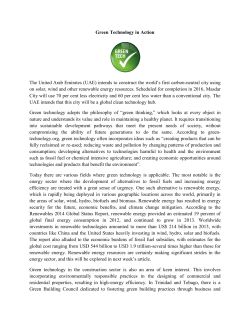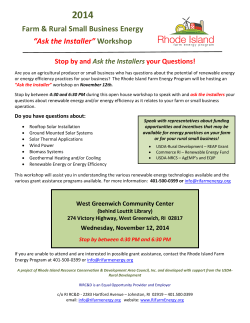
Renewable Energy Sources - Astoria High School
Renewable Energy Sources Lesson Plan: NRES F1-2 1 Anticipated Problems 1. What are renewable energy sources? 2. What are advantages and disadvantages of renewable energy sources? 2 Terms 3 biomass biopower co-firing direct-fire system energy exhaustible energy source fermentation gasification Terms 4 generator geothermal power hydropower inexhaustible energy source methanogenesis nonrenewable energy source photovoltaic system renewable energy source Terms 5 solar power tidal power transesterification turbine turbulence wave power wind power Energy Energy is the ability to do work. Energy exists in different forms, including: 6 Heat Kinetic or mechanical energy Light Potential energy Electrical Chemical Other Sources Energy The modern world is greatly dependent on energy. 7 Sources of energy are considered inexhaustible or exhaustible and renewable or nonrenewable. Inexhaustible 8 An inexhaustible energy source is a source that will not run out in the foreseeable future. Sunlight Wind Geothermal energy Exhaustible An exhaustible energy source is a source available in limited quantity that can be completely used. 9 Some exhaustible natural sources are renewable, while others are nonrenewable. Renewable & Nonrenewable 10 A renewable energy source is a source that can be replaced naturally. A nonrenewable energy source is a source that cannot be replaced after use. Fossil fuels Nuclear energy Renewable Energy Sources Renewable energy sources meet about 8 percent of the total energy needs in the United States. 11 Ten percent of electricity is produced using renewable energy sources. Nearly all electricity is produced with some type of turbine. Turbine A turbine is any kind of machine that converts kinetic energy of a moving fluid or gas to mechanical power by the impulse or reaction of the fluid or gas with a series of buckets, paddles, or blades arrayed around a wheel or cylinder. 12 Uses: water, wind, steam, or some other force As the turbine spins, mechanical energy is transferred to a generator. Generator 13 A generator is a device that converts mechanical energy into electrical energy. Inside a generator, metal coils are surrounded by magnets. The mechanical energy produced by the turbine causes the metal coils to spin past the magnets. This action creates electricity. Renewable Energy Sources 14 The energy is then conveyed along transmission lines to homes and businesses. The five renewable energy sources used most often are: Hydropower wind power Solar power Geothermal power Biopower Hydropower Hydropower is power in the form of electrical energy produced when the mechanical energy of moving water is transferred by a rotating turbine to a generator. 15 In the United States, hydropower accounts for about 6 percent of the total electricity. 16 Types of Hydropower Hydroelectric power plants associated with dams or built along streams. Tidal power - electricity is generated through the turning of turbines by ocean tides. Wave power is energy from ocean surface waves used to turn turbines for the production of electricity. 17 18 19 20 Wind Power Wind power is energy harnessed from the force of the wind used to create electricity. 21 According to the U.S. Department of Energy, wind power has been the fastest-growing source of new electric power generation for several years. In 2009, generation from wind power increased 33.5 percent over 2008 numbers, bringing the share of total generation to 1.9 percent. 22 Wind Power Wind is produced from the uneven heating of the earth’s surface by the sun. The production of electricity requires wind at high speeds. A wind energy system requires that the rotors attached to the turbine move smoothly and avoid turbulence. Turbulence is a situation caused by the unsteady movement of air or water. 23 24 Solar Power Solar power is energy from the sun used by mechanical solar systems to produce electricity or to capture the sun’s heat for the purpose of heating space or water. 25 Photovaltaic System A photovoltaic system is a system that converts solar radiation into direct-current electricity using semiconductors. 26 Semiconductor materials, such as silicon, cause electrons to separate from the atom. The electrons are captured through an electrical circuit and provide usable electricity. 27 Geothermal Power Geothermal power is heat energy harnessed from within the earth to produce electricity. 28 “Geothermal” means heat (thermal) from the earth (geo). Heat from the earth heats water in underground reservoirs. Reservoirs with water temperatures from 225° to 600°F can be used to produce electricity. 29 30 BioPower Biopower is electric power produced from biomass. Biomass is living and recently living biological material that can be used as fuel or for industrial production. 31 Agricultural or forestry wastes Organic materials from municipal and industrial wastes 32 Biomass Biomass can be burned directly or converted into another usable form of energy. 33 Supplies about 4% of the energy used in the US Single largest source of non-hydro renewable electricity Direct-Fire System A direct-fire system is a system in which biomass is burned to produce steam that drives a turbine that produces electricity with a generator. 34 Similar to the process used in coal or oil plants Most electricity generated from biomass is produced by direct-fire incineration. Co-Firing Co-firing is the burning of biomass in combination with fossil fuels in power plants. 35 The addition of biomass as a fuel can significantly reduce air pollutants, especially sulfur emissions. Most economical use of biomass, uses existing technologies Methanogenesis Methanogenesis, or anaerobic digestion, is the process of microorganisms feeding on dead plant and animal tissue in the absence of oxygen to produce methane. 36 Methane is the main ingredient in natural gas. Methane gas may be burned to create steam and run a generator or be used in micro-turbines and fuel cells. Gasification Gasification is the heating of biomass at high temperatures in an oxygen-free environment to create gases such as carbon monoxide, hydrogen, and carbon dioxide. The mixture of gases is referred to as syngas The syngas is then burned to create electricity. 37 One of the most efficient and least polluting of the conversion technologies. Transesterification A chemical reaction is a process of combining plant- or animal-derived products to create products such as biodiesel. Transesterification is the chemical reaction process that involves combining triglycerides or soybean oils with alcohols to produce biodiesel. The reaction is catalyzed with the addition of an acid or a base. 38 Fermentation Fermentation is a process in which an alcohol (ethanol) is produced from biomass. 39 Biomass is broken down into basic sugars. Yeast is added to convert the sugars to ethanol. Advantages & Disadvantages 40 Renewable energy sources have both advantages and disadvantages. Hydropower 41 Advantages: Clean and nonpolluting Dams can prevent flooding Tidal power is inexpensive Wave power is highly efficient, low cost to operate Wave power: no emissions Hydropower Disadvantages Dams: expensive to build Dams: harmful environmental consequences Tide power: limited to ten hours daily 42 Wave power: damage to the marine ecosystem if improperly placed Wind Power 43 Advantages No water or air pollution Inexpensive, self maintaining, self-reliant Disadvantages Intermittent in many places May be considered unattractive in communities Require a large plot of land Geothermal Power 44 Advantages Last longer than traditional systems Once in operation, the energy is practically free No water or air pollution Disadvantages Limited areas of the world can support Higher initial cost BioPower 45 Advantages Good commercial electric power generation option Available almost everywhere May reduce municipal, agricultural, industrial waste Disadvantages Can contribute to global warming More expensive than fossil fuels Less efficient Review 46 What percentage of renewable energy sources meet the total energy needs in the US?\ List the five renewable energy sources used most often. What are some advantages of renewable energy sources? What are some disadvantages of renewable energy sources?
© Copyright 2025











